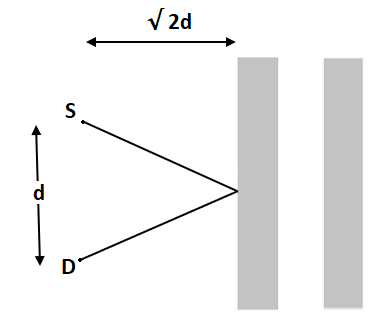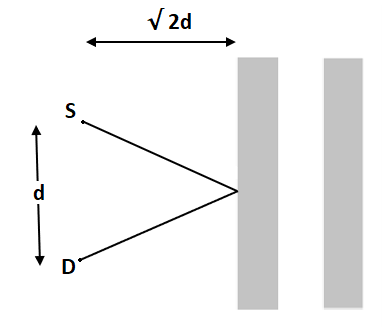
A source S and a detector D are placed at a distance d apart. Big cardboard is placed at a distance \[\sqrt 2 d\] from the source and the detector as shown in the figure (below). The source emits a wave of wavelength = \[\dfrac{d}{2}\] which is received by the detector after reflection from the cardboard. It is found to be in phase with the direct wave received from the source. By what minimum distance should the cardboard be shifted away so that the reflected wave becomes out of phase with the direct wave?

Answer
216k+ views
Hint: The path difference can be defined as the distance travelled by the two waves at the meeting point. It can measure how much the wave is shifted from another.
Formula used:
Phase difference=\[2\pi \lambda \times \]path difference
Where \[\lambda \] is wavelength.
Complete step by step solution:
Given wavelength =\[\lambda = \dfrac{d}{2}\]
The distance between the source and the detector is d.
The distance of the cardboard from the source and detector is \[\sqrt 2 d\].

Image: Source and the detector shown in figure
The initial path difference is,
\[2\left( {\sqrt {{{\left( {\dfrac{d}{2}} \right)}^2} + 2{d^2}} } \right) - d\]
Let x be the distance to which it is shifted. Then the reflected wave becomes out of phase with the direct wave. Then the path difference is,
\[2\left( {\sqrt {{{\left( {\dfrac{d}{2}} \right)}^2} + {{\left( {2d + x} \right)}^2}} } \right) - d = \left( {2d + \dfrac{d}{4}} \right)\]
By solving, we get
\[\sqrt 2 d + x = 1.54d\]..............(by using\[\sqrt 2 = 1.414\])
\[\Rightarrow x = 1.54d - 1.414d\\ \therefore x{\rm{ = 0}}{\rm{.13d}}\]
Therefore, 0.13d is the minimum distance should the cardboard be shifted away so that the reflected wave becomes out of phase with the direct wave.
Note: The phase difference can be defined as the difference in the phase of the two travelling waves. The maximum path difference will be produced where the path difference between the two waves is equal to a whole number of the wavelengths.
Formula used:
Phase difference=\[2\pi \lambda \times \]path difference
Where \[\lambda \] is wavelength.
Complete step by step solution:
Given wavelength =\[\lambda = \dfrac{d}{2}\]
The distance between the source and the detector is d.
The distance of the cardboard from the source and detector is \[\sqrt 2 d\].

Image: Source and the detector shown in figure
The initial path difference is,
\[2\left( {\sqrt {{{\left( {\dfrac{d}{2}} \right)}^2} + 2{d^2}} } \right) - d\]
Let x be the distance to which it is shifted. Then the reflected wave becomes out of phase with the direct wave. Then the path difference is,
\[2\left( {\sqrt {{{\left( {\dfrac{d}{2}} \right)}^2} + {{\left( {2d + x} \right)}^2}} } \right) - d = \left( {2d + \dfrac{d}{4}} \right)\]
By solving, we get
\[\sqrt 2 d + x = 1.54d\]..............(by using\[\sqrt 2 = 1.414\])
\[\Rightarrow x = 1.54d - 1.414d\\ \therefore x{\rm{ = 0}}{\rm{.13d}}\]
Therefore, 0.13d is the minimum distance should the cardboard be shifted away so that the reflected wave becomes out of phase with the direct wave.
Note: The phase difference can be defined as the difference in the phase of the two travelling waves. The maximum path difference will be produced where the path difference between the two waves is equal to a whole number of the wavelengths.
Recently Updated Pages
JEE Atomic Structure and Chemical Bonding important Concepts and Tips

JEE Amino Acids and Peptides Important Concepts and Tips for Exam Preparation

Electricity and Magnetism Explained: Key Concepts & Applications

Chemical Properties of Hydrogen - Important Concepts for JEE Exam Preparation

JEE Energetics Important Concepts and Tips for Exam Preparation

JEE Isolation, Preparation and Properties of Non-metals Important Concepts and Tips for Exam Preparation

Trending doubts
JEE Main 2026: Application Form Open, Exam Dates, Syllabus, Eligibility & Question Papers

JEE Main Correction Window 2026 Session 1 Dates Announced - Edit Form Details, Dates and Link

Derivation of Equation of Trajectory Explained for Students

Hybridisation in Chemistry – Concept, Types & Applications

Understanding the Angle of Deviation in a Prism

Understanding Collisions: Types and Examples for Students

Other Pages
JEE Advanced Marks vs Ranks 2025: Understanding Category-wise Qualifying Marks and Previous Year Cut-offs

Units And Measurements Class 11 Physics Chapter 1 CBSE Notes - 2025-26

NCERT Solutions For Class 11 Physics Chapter 8 Mechanical Properties Of Solids

Motion in a Straight Line Class 11 Physics Chapter 2 CBSE Notes - 2025-26

NCERT Solutions for Class 11 Physics Chapter 7 Gravitation 2025-26

How to Convert a Galvanometer into an Ammeter or Voltmeter




